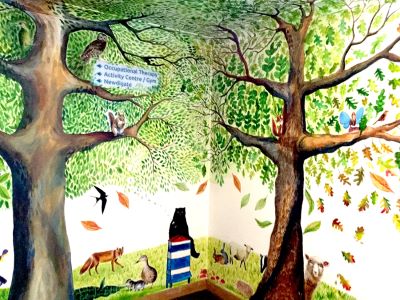Case Study: Recovery Tree mural projects in Elysium Healthcare secure hospitals
Authors(s), Creator(s) and Contributors: Dr Maria Hayes
Publication Date: 18/08/2021
Categories: Case Studies
Partner(s): Elysium Healthcare
Funder(s): Elysium Healthcare
Introduction
Maria Hayes is an artist facilitator with 34 years of experience working creatively with people of all ages and abilities. In July 2019 she was invited to design and paint a Recovery Tree mural in Elysium Healthcare’s Aberbeeg Hospital by Jessica Wilson (Director). Elysium Healthcare’s CEO Joy Chamberlain saw the work and commissioned Maria to deliver further projects in other hospitals. Jessica Wilson supervises the work. To date (August 2021) fourteen projects have been completed with a further ten hospitals on a waiting list. Maria has co-created murals in CAMHS units and with adults in open rehab, locked rehab, low and medium secure hospitals. The projects take place once month and last for one week. They follow the same structure, but have differing results, responding to the s
The Challenge
Secure hospitals are difficult places for artists to access. Protocols and securities seem hostile to practitioners not used to the necessary regimes. Patients are very hard to engage. Jessica Wilson discovered the power of the arts in a mental health care setting when she used storytelling to calm a patient during a psychotic episode. She is now an advocate for Arts in Health. Her initiative to bring Maria in was risky, so the project was evaluated and assessed daily. Initial resistance and suspicion encountered from both patients and staff were soon dispelled. The many safety challenges to meet regarding having the materials and equipment on the ward were dealt with and thus far patients have always shown a high level of respect. Before each project Maria and Jess contact the hospital
The Approach
The tree, drawn and painted from memory, observation and gesture, depicts progress through the four seasons. It is populated with wildlife and pets suggested by the patients and staff and these are painted from photographs. Participants are encouraged and supported to challenge themselves creatively and technically, while being tutored as they work. On the first day the tree is drawn out and the first layer of paint added, with suggestions invited for creatures to inhabit the tree. Soon photos appear and the stories that accompany them are shared. The second and third day are spent adding leaves and creatures – drawn first, then the first layer of paint added. A second layer of paint will be worked into the tree trunk and branches. The fourth and fifth day sees all the leaves painted on and the creatures completed. Before the end of the fifth day, self-adhesive message leaves are added. Maria works alongside the participants – they co-create the mural. Maria’s aim is that everyone participates and paints at least one leaf. Participation includes: - Drawing and Painting (Active) - Watching and looking (Reflective) - Discussing and the mural, art and life (Dialectic) - Just ‘being’ (Presence)
The Impact
Participants engage with an activity that is mindful, creative and that leaves a trace of co-operative action. Relationships are formed as work progresses. The work is not therapy, but is ‘Art with a capital A’ and has a therapeutic value and effect. After each participatory session Maria invites patients to make a brief evaluation of feelings before and after taking part. On the last day staff are requested to complete longer evaluation feedback forms to collect reflections, observations and impacts. Maria uses an iPad camera to document progress, but only patient hands may be photographed. In addition she keeps a daily diary to use together with photos and feedback comments to complete an illustrated report on each project. These projects are time limited interventions with a professional artist who is neither health staff nor patient, but ‘other’. For the duration, patients demonstrate and experience that they are more than their illness. The staff feedback observes that the projects progressively calm the ward, increase patients and staff’s sense of wellbeing and can engage some hard to reach patients in ways that other activities do not. One frequent and unexpected observation is that these projects are great levellers for staff and patients. Doctors and pa
Lessons Learned
Every project offers different challenges and things to learn. Maria adapts and refines her practice each time. She has also learned how important it is to download after sessions and values having Jessica as a supervisor to do this with. The nature of these environments mean that there is only so much planning that will work. There is no way to tell what the space or the wall will be like until Maria arrives, nor who the staff and patients will be, so she needs to be adaptable, accepting and inventive. Maria aims to use the space as creativ
The Legacy
Fourteen murals in secure units across England and Wales stand testimony to this project. Staff report that the murals are respected and protected on the whole. Other walls may be marked or have liquids thrown at them during a crisis, but not the murals. They remain intact and are enjoyed even by those who did not participate in their creation. Maria met one patient twice – she had moved on to a less secure ward. She participated in both mural projects. In the first she was relatively passive, but in the second she took a lead role and relish
Website and Social Media Links
www.mariahayes.info https://www.elysiumhealthcare.co.uk/
Contact Details
Dr Maria Hayes, drmariahayes@gmail.com 07817297922
Tags: Visual art, Mental health, NHS, secure hospitals, Adults, children

